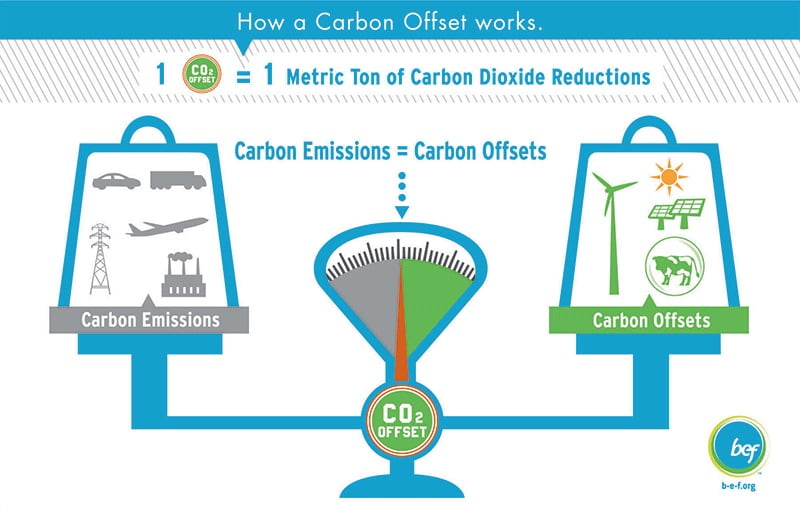Many of us are concerned about climate change and eager to take action. We’ve added insulation to our homes and reduced drafts. We’ve upgraded our water heaters or heating and cooling systems. Some have even purchased electric vehicles. It may seem like we’ve done a lot, but there’s still much to do.
While significant progress has been made, these efforts will not offset the greenhouse gas emissions that are embedded in the food we eat, the goods we buy, the roads we drive on, the electric vehicles we drive, the books we read, the trash we send to the dump, the buildings we work in, or the flights we take for business and pleasure.
It’s time to learn a new metric so we can understand how our personal lifestyle affects greenhouse gas emissions. Greenhouse gas emissions are measured in metric tons (MT). According to the World Bank, the average American is responsible for emitting around 16 metric tons (MT) of greenhouse gases (GHGs) or Carbon Equivalents (C02e) each year per person. That’s far higher than the average European who emits only 6 MT or the global average of 5 MT per person. While the climate crisis is already upon us, it will become far worse. To reduce the most extreme impacts of climate change, everyone on Earth, especially Americans, must slash our GHG emissions to just 2 metric tons CO2e/year.
We need to move fast. So what more can each of us do to support the rapid shift to a low carbon society?
First Things First
Direct action is the top priority. We can start by upgrading all the major energy using objects in our lives. But few of us can do this overnight. What we can do now is make a commitment that our future purchases will be climate friendly.
When we’re ready for a new car, buy an electric vehicle. When the furnace needs replacing, install a high-efficiency heat pump. Does the roof need replacing? Include a solar electric (photovoltaic) system in the project and consider solar roofing material to reduce the overall expense.
Is your home too small for your growing family or is it too big for your empty nest? Make the next one a zero energy house. Anyone who can afford to buy a different house, can afford to make it a zero energy house since they are usually cost comparable to standard homes and cost less to own. Make your next home purchase a better, more energy efficient, home with a lower carbon footprint.
This long-term commitment to direct action is essential, but the planet can’t wait for our carbon reduction plans to be fully implemented. Most of us want to take meaningful climate action now, but our actions may not make it all the way to carbon neutral in one big leap. So, in addition to our own efforts in our own sphere of influence, we should all consider carbon offsets as a stepping stone to a post carbon, greenhouse gas free life.
Carbon Offsets
When we can’t make direct reductions, or when the reductions we do make do not take us to carbon neutral, there is still a way forward. We can invest in carbon reductions made by others by purchasing carbon offsets also known as carbon credits. Carbon offsets are payments or “investments” made by an individual, company, or organization to fund projects that reduce GHGs. These projects might include carbon saving or carbon sequestration projects, such as wind energy farms, solar farms, biogas energy, tree planting, ecological agriculture, or provision of low carbon cookstoves in third world countries. (Renewable Energy Credits are similar but specifically target energy producing projects to offset fossil fuel based utility power, and are measured in megaWatt-hours rather than metric tons of CO2e.)

Source: Bonneville Environmental Foundation
Paying for someone else’s carbon reduction actions may seem like dodging your own responsibility. But given the scale of the challenge, we must immediately do our part to offset GHG emissions that are not under our control. It’s necessary for a rapid transition towards a zero carbon world. By purchasing carbon offsets, we are investing in our future, the future of our children and grandchildren, and in the future of our world. What investment could be more important?
One criticism of carbon offsets (and climate action in general) is that individual reductions are nothing but a drop in the ocean, but this belief is simply wrong. Carbon offsets are not too small to matter. Greenhouse gases are entering and leaving Earth’s atmosphere everywhere there are human beings living and working. Removing GHGs from any location on Earth benefits the system as a whole. It is the accumulation of every individual’s emissions that created this crisis. The impact of every house, vehicle, light, and hamburger floats into the atmosphere. The climate crisis stems from the long-term accumulation of a vast number of tiny contributions that became an enormous destructive force. Our individual contributions added up to create climate change, so our individual reductions accumulate just the same. We broke it, and we can fix it. At this moment, one of the best ways to accelerate our individual reductions is by purchasing carbon offsets.
Additionality
Many people are skeptical that carbon offsets are real and need to be reassured that they are purchasing quality offsets that will actually reduce GHGs. To truly offset GHGs, a project must use the funding they receive to create new, or “additional,” reductions. In other words, to qualify as a quality carbon offset, the financial investment must create new GHG reductions that would not have occurred without the investment. This concept is known as “additionality.” For example, if you invest in a megawatt-hour of renewable generation it must actually offset a megawatt-hour of fossil fuel fired generation that would not have occurred without the investment. It is a clear concept that is sometimes complex in its implementation, but is well worthwhile.
Not Perfect
Critics of carbon offsets point to several legitimate issues. How effective is the offset in actually reducing GHGs? Will trees planted in Africa grow to maturity? Would the wind farm have been built anyway? Is a high percentage of the offset payment actually reaching the project? These are all valid questions. Most of us want to know that we are getting good value for the money we are investing. This is why third party certification of carbon offsets is so important.
Certification
While carbon offsets may be new to many of us, they have been around for decades – long enough to develop international markets and rigorous certification standards. These standards offer a way to determine that the carbon reductions offered by a project are real, measurable, permanent, independently verified, and would not have taken place without the finance provided by the sale of offset credits. Several organizations certify offsets and are worth checking out.
The United Nations Clean Development Mechanism directs carbon offset investments from high-income countries to investments in low- and middle-income countries. They issue tradable Certified Emissions Reductions for projects around the world and sell offsets to support them. Other highly reputable organizations include American Carbon Registry, Climate Action Reserve, Verra, Cool Effect, and Gold Standard. Before purchasing carbon credits, we need to be sure that the issuer and the project participate in one of these or a similar certification program.
Time to Act
Because the transition to a zero carbon society must be swift and decisive, it’s important to move immediately along multiple fronts. Certainly, reducing GHGs within our own spheres of influence (home, business, and community) is essential and the first priority. But there is much outside our immediate influence where carbon offsets can play an important role.
Carbon offsets raise awareness of the climate crisis and provide visibility to projects around the world that reduce GHGs. They offer all of us – consumers, homeowners, renters, and businesses – an action that can be taken immediately to reduce our known climate impacts, especially those that may otherwise be without an immediate solution. They support the development and deployment of innovative technologies. And they demonstrate a commitment toward climate action. Most importantly, offsets provide an effective way for us to take action instead of feeling helpless in the face of what could feel like an overwhelming challenge.
A New Tradition
While purchasing carbon offsets may not be perfect, the vast majority go to high quality projects that deserve our support. All of us, especially those of us on tight budgets, may want to consider giving or asking for carbon offsets as holiday or birthday presents in place of gifts of commercial goods. Or, we may want to commit to an ongoing yearly or monthly contribution to carbon offsets in the tradition of tithing. Moving towards a new tradition of gifting carbon credits as well as purchasing them for ourselves will directly reduce carbon in the atmosphere by eliminating the embodied carbon of the goods not purchased. And, it also supports important carbon offset projects around the world – a big win-win for everyone.
Coming Soon: How to calculate carbon footprints and to buy carbon offsets.

